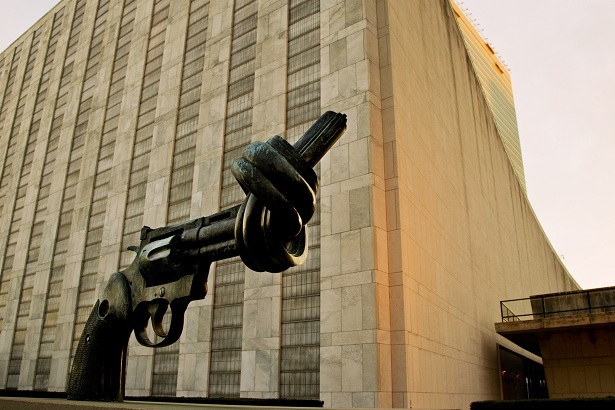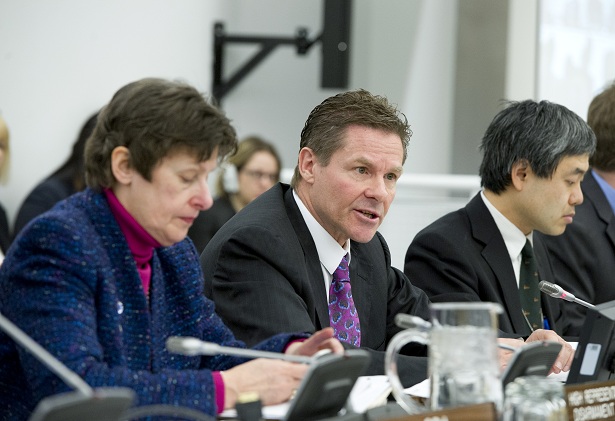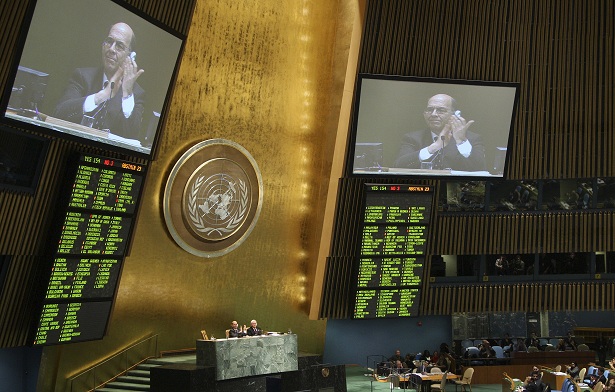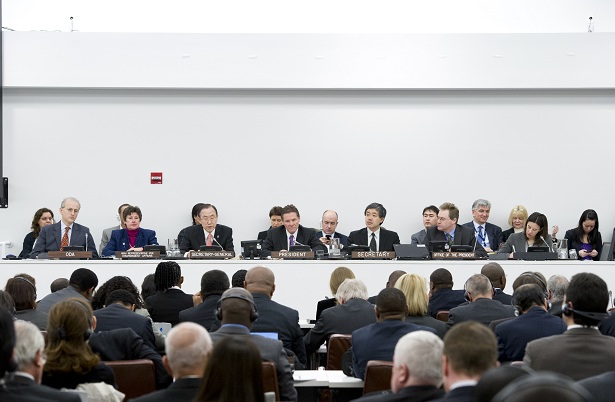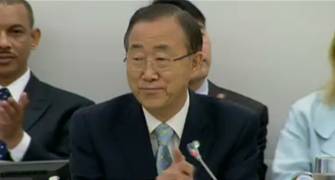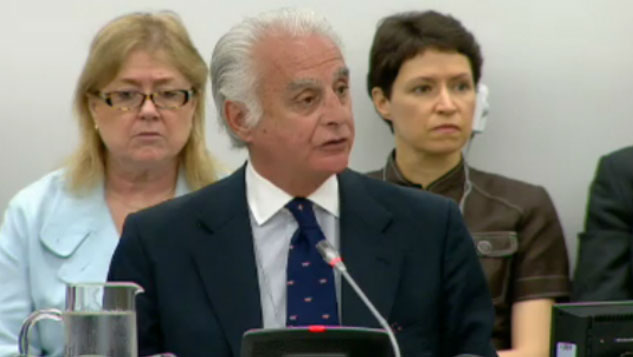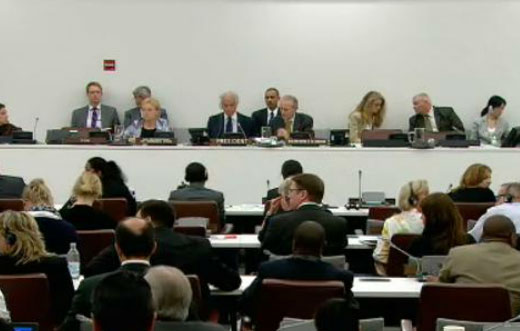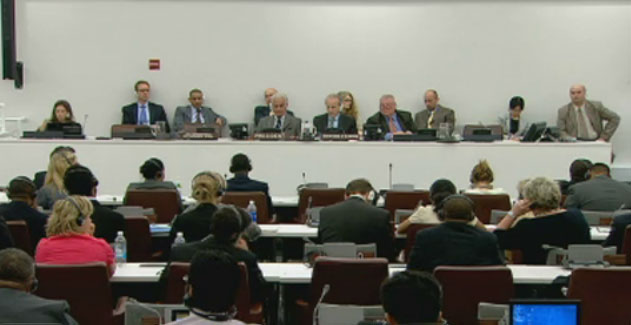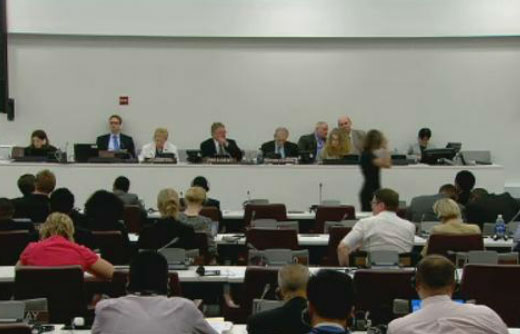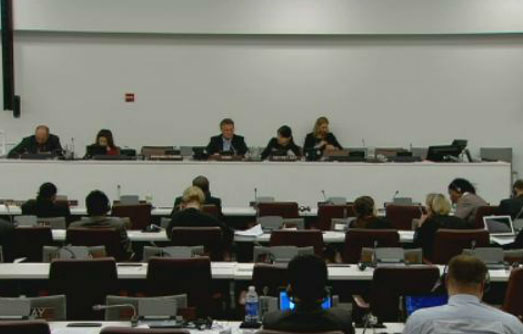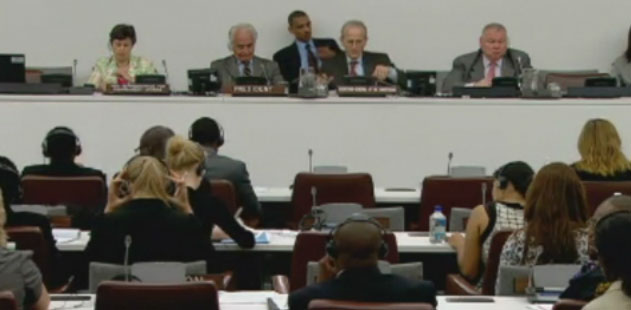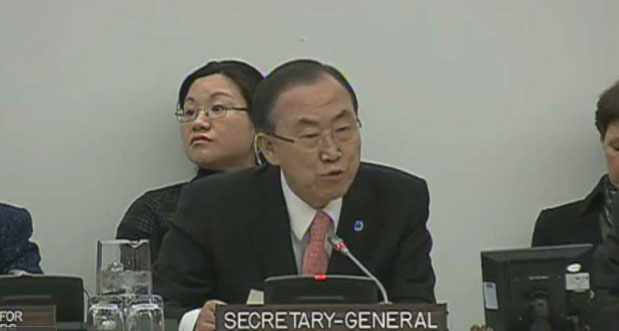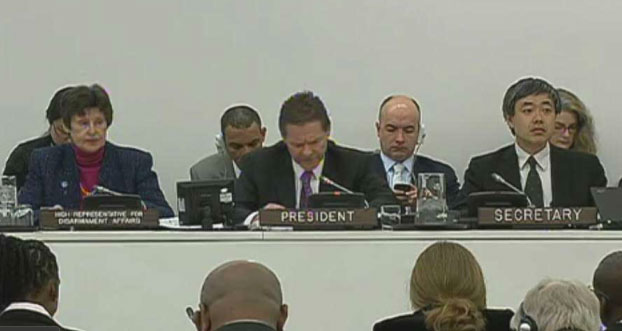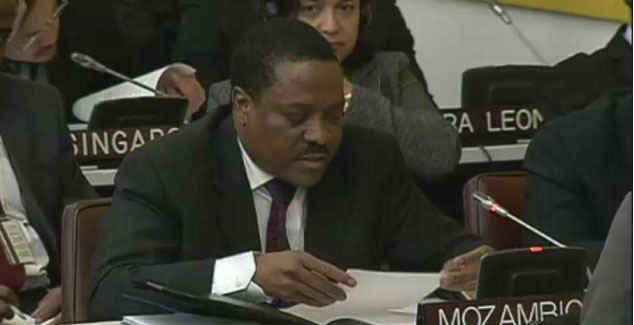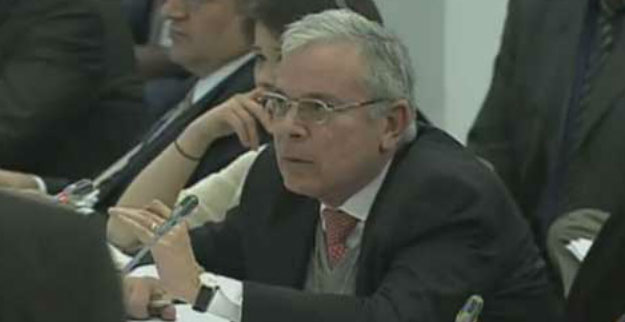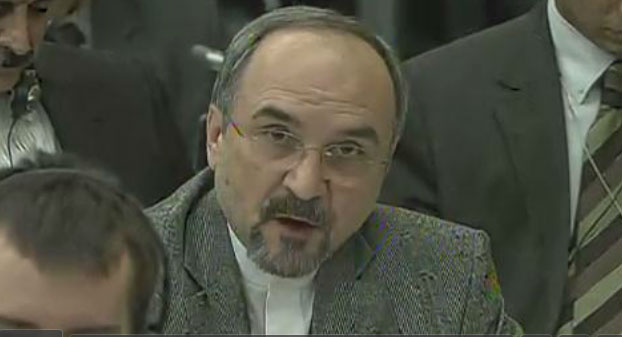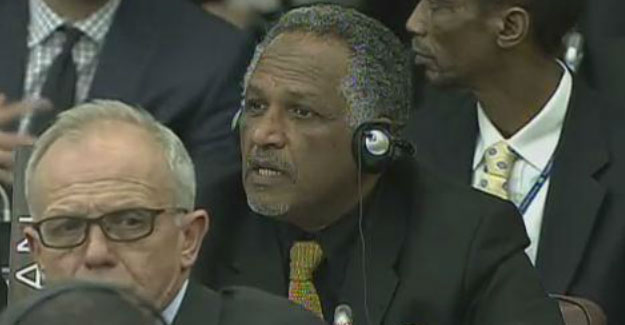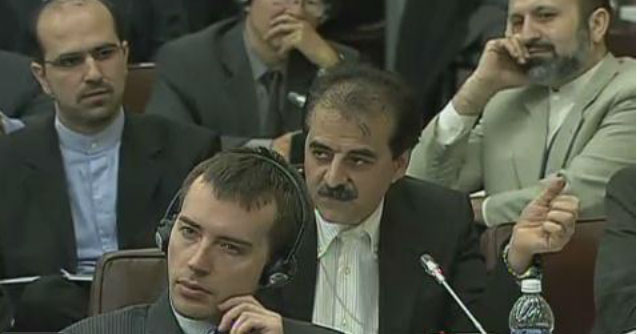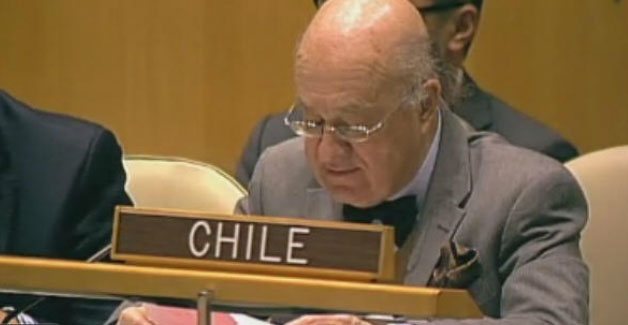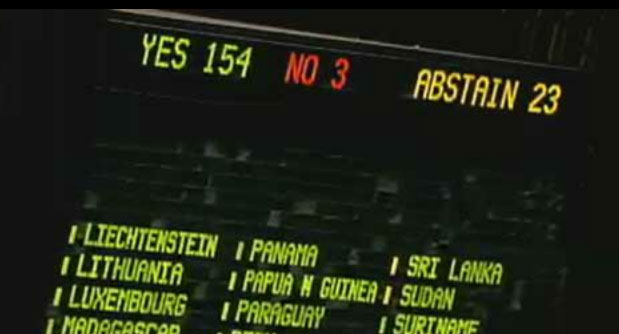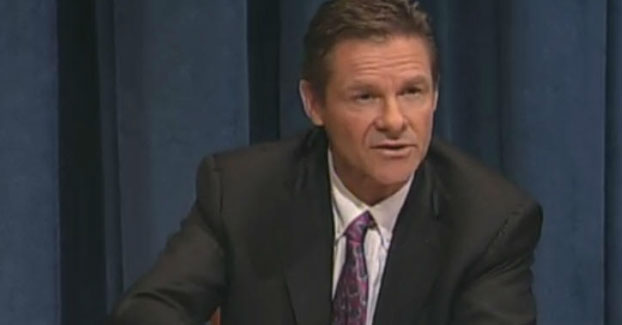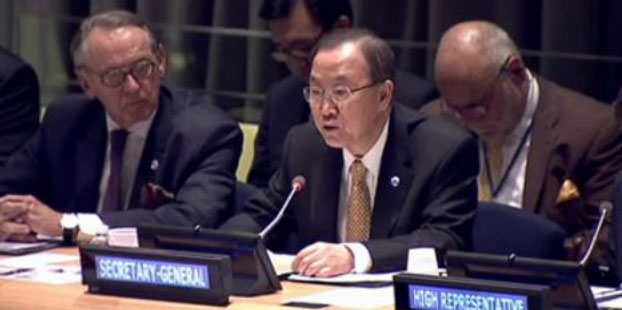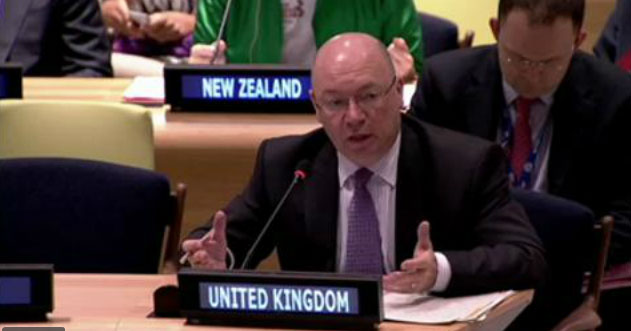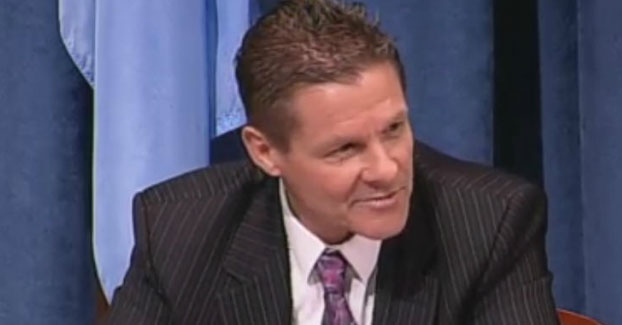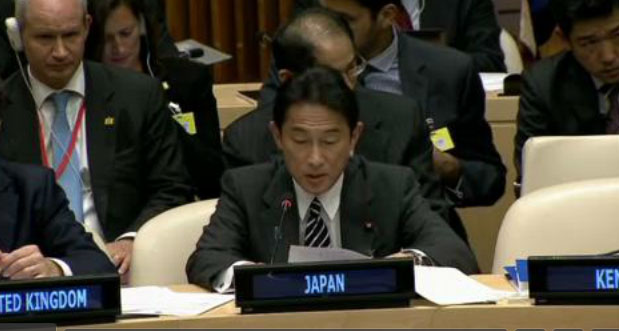|
Arms Trade Treaty
New York, 2 April 2013
By Peter Woolcott
Permanent Representative of Australia to the United Nations in Geneva and Ambassador for Disarmament
1. Historical Context
After the Cold War, the devastating impact of widespread armed violence, particularly in situations of poverty and extreme inequality, came to the fore of the international community’s attention. In the early to mid-1990s, to help counter the proliferation of conventional arms, several sets of guidelines or principles on arms transfers emerged among groups of countries, which included some of the largest arms exporters. The Permanent Five (P5) members of the United Nations Security Council and Germany were the top six leading suppliers of major conventional weapons during 1993-1997.2 The risk of human rights violations in a recipient country was one of the reasons for many supplier countries to follow a restrictive arms transfer policy.3 Recognising that arms proliferation was a global problem, the United States called on the P5 countries to meet at senior levels to discuss the establishment of guidelines for transfers of conventional arms. Despite the P5’s commitment in 1991 to elaborate a set of “Guidelines for Conventional Arms Transfers” which included a set of arms transfer criteria, serious disagreements meant that the P5 process ended by 1992. Meanwhile, in 1991, the United Nations Register of Conventional Arms was established as the key international mechanism to promote predictability and transparency in the conventional arms trade. An International Code of Conduct on Arms Transfers developed by a group of Nobel Peace Prize laureates, led by Dr. Oscar Arias, the former President of Costa Rica, was launched in 1997. With Western Europe as the second largest arms exporting region,4 by 1998, the European Union became the first group of States to accept a regional Code of Conduct on Arms Exports. Illicit trafficking was particularly an issue in Africa, Latin America, the Pacific and South-East Asia. In 1999, a study carried out by the International Committee of the Red Cross (ICRC) demonstrated that the unregulated availability of weapons was a major contributing factor to civilian suffering during and after armed conflicts and increased civilian casualties.5 As long as weapons were too easily available, violations of international humanitarian law and human rights law would more likely occur and the provision of humanitarian and development assistance would be hampered. A 2003 report by the Small Arms Survey attributed death, injury, violations of human rights, international humanitarian law, forced displacement and economic collapse, in Fiji, the Solomon Islands and Papua New Guinea, to the ready availability of conventional weapons.6 Progress in the United Nations was first realised in the area of small arms and light weapons, which were seen as the preferred weapon in modern-day internal armed conflicts and armed violence. A consensus decision to address small arms and light weapons was achieved at the United Nations Conference on the Illicit Traffic in Small Arms and Light Weapons in All Its Aspects, which took place from 9 to 20 July 2001. The 2001 Conference resulted in the non-binding United Nations Programme of Action to Prevent, Combat, and Eradicate the Illicit Trade in Small Arms and Light Weapons, in All Its Aspects. By 2006, international attention shifted back to concerns over conventional weapons as a whole. The fact that the international trade in bananas was more tightly regulated under international law than conventional arms was beginning to resonate strongly with many States. Following a civil society campaign supported by the group of Nobel Peace Prize Laureates, seven Governments (Argentina, Australia, Costa Rica, Finland, Japan, Kenya and the United Kingdom of Great Britain and Northern Ireland – known as the “co-authors”) sponsored the first United Nations General Assembly resolution on an arms trade treaty in 2006.7 The resolution recognised that the absence of common international standards on the import, export and transfer of conventional arms was a contributory factor to conflict, the displacement of people, crime and terrorism as well as undermining peace, reconciliation, safety, security, stability and sustainable development. The road from 2006 to the adoption of the Arms Trade Treaty (ATT) on 2 April 2013 was not straightforward. States approached the negotiations from a wide range of perspectives. Exporting States saw the ATT as a framework to allow their defence industries to participate more transparently in the legitimate international arms trade and level the playing field with an agreed set of standards. Along with transit and trans-shipment States, they wanted to ensure that any new regulatory burdens were not excessive. Importing States wanted an ATT that brought greater clarity to their ability to choose a defence mix in pursuit of their legitimate right to self-defence. Political will to reach a consensus on the Arms Trade Treaty was never a foregone conclusion. The United Nations had not seen success in negotiating a multilateral arms control agreement since the 1990s.8 The adoption of the ATT by an overwhelming majority of States in the General Assembly was, therefore, a historic achievement for the United Nations and multilateralism. 2. The Negotiating History The ATT negotiating process started with the General Assembly’s request for the Secretary-General to seek views from Member States on the feasibility, scope and draft parameters of an arms trade treaty. This yielded replies from around 100 States in 2007, signalling the interest and importance of this first step towards a treaty.
The General Assembly, in its resolution 64/48 of 2 December 2009, decided to convene a United Nations Conference on the Arms Trade Treaty to meet for four consecutive weeks in 2012 to elaborate a legally binding instrument on the highest possible common international standards for the transfer of conventional arms.9 In particular, it was decided that the Diplomatic Conference would be undertaken in an open and transparent manner, on the basis of consensus, to achieve a strong and robust treaty.10 Three substantive Preparatory Committee sessions were held in 2010 and 2011.11 A final fourth session, held from 13 to 17 February 2012, focussed largely on procedural matters. The Diplomatic Conference was held in New York from 2 to 27 July 2012 under the Presidency of Ambassador Moritán. The Conference, however, was delayed by almost two days due to questions concerning the status and participatory rights of the Holy See and Palestine. A compromise was reached which allowed the Conference to open on 3 July. On 9 July, a provisional programme of work was approved which established two main committees, working in parallel until 20 July, to conduct negotiations on the elements of the ATT. On 26 July 2012, the President’s comprehensive draft treaty text12 was presented but did not find consensus. Divergent views over key areas of the text remained until the last hours of the Conference. In the end, some delegations argued for more time to examine the draft text. In its resolution 67/234A of 24 December 2012, the United Nations General Assembly decided to convene the Final United Nations Conference on the Arms Trade Treaty from 18 to 28 March 2013, with the 26 July 2012 draft treaty text being the basis for future work. The General Assembly also decided that the Final Conference would be governed by the July 2012 Conference’s rules of procedure, in an open and transparent manner, utilising the modalities of the July 2012 Conference, applied mutatis mutandis. Ambassador Peter Woolcott of Australia was nominated President-designate of the Final Conference. Delegates and civil society were well prepared leading into the 2013 Final Conference. The 26 July 2012 text was known intimately and its impact on particular national interests was well understood. With only nine working days allocated for the Final Conference, it was critical for the Conference to get to work without delay. When the Final Conference opened on 18 March, the issue of the status of the Holy See and Palestinian delegations had been quietly settled. A novel arrangement had been agreed by which the Holy See and the State of Palestine would be seated alphabetically among United Nations Member States with speaking rights during the Conference, but short of an “all States” arrangement. Both the Holy See and the State of Palestine noted that this compromise was reached because they did not want to block negotiations towards a strong and effective ATT, but said this arrangement would not be a precedent for future United Nations meetings. This result demonstrated that New York delegations recognised that the negotiations needed to get to work quickly. This was a key factor in helping preserve the confidence of delegations in the negotiations – a reminder of the value in multilateral negotiations of having settled procedure. After the build-up and disappointment of the July 2012 Conference, there was considerable political will to collectively reach an outcome at the Final Conference. During the Final Conference, delegates were provided with three draft texts of the President which were progressively stronger than the last, with the goal of broadening the supportive constituency and bringing all delegations along. Facilitators were also appointed by the President to conduct informal discussions on key aspects of the text, which was a useful process in confirming where a likely consensus would be.13 Some of these discussions led to a significant reshaping of elements of the 26 July 2012 text as well as adding important new elements. However, some discussions indicated that there could be little further development of a particular issue. As a result, the treaty text was balanced and as strong as it could be while still holding together the disparate interests demonstrated at the Conference. No delegation left the Final Conference getting everything they wanted, but no one walked away empty-handed. While there was initially a considerable divergence of views, delegations ultimately demonstrated a preparedness to take ownership of the process and compromise in order to achieve an effective and balanced treaty. Delegations understood that balance was vital to ensuring the legitimacy of the final treaty text. Throughout the negotiating process, a consensus outcome remained the goal. While this was not ultimately achieved, the Final Conference showed what was possible when delegations engaged in a consensus-governed process and were determined to strive for a negotiated consensus outcome. On the final evening of 28 March 2013, the President ruled that due to the objections of the delegations of Iran (Islamic Republic of), Democratic People’s Republic of Korea and the Syrian Arab Republic, there was not a consensus in the Final Conference for the adoption of the draft treaty text. Although the Conference did not adopt the treaty, the negotiating process produced a robust text with almost universal acceptance. It was the willingness of States to stay the course with the United Nations system that helped guarantee the broadest possible constituency of States for the ATT, adding to its legitimacy and potential for effective action into the future. General Assembly resolution 67/234A, which had convened the Final Conference, had a built-in redundancy, an off-ramp. The President was required by the resolution to report to the General Assembly on the outcome as soon as possible after the Final Conference concluded. This allowed delegations legitimately to take the text to the General Assembly for adoption. This proved to be the measure of last resort. On 2 April 2013, Ambassador Woolcott’s final text of the ATT was adopted by General Assembly resolution 67/234B.14 3. The Treaty’s Key Provisions
The minimum scope of arms covered by the Treaty begins with article 2, paragraph 1, which sets out the categories of conventional arms to which the Treaty shall apply, being the seven categories covered by the United Nations Register of Conventional Arms15 and an eighth category on small arms and light weapons. Article 3 of the Treaty requires States parties to regulate the export of ammunition/munitions fired, launched or delivered by the conventional arms covered under article 2, paragraph 1, and to apply articles 6 and 7 prior to authorising their export. Similarly, article 4 requires States parties to regulate the export of parts and components where the export is in a form that provides the capability to assemble conventional arms covered under article 2, paragraph 1, and to apply articles 6 and 7 prior to authorising their export. Article 6 addresses explicitly prohibitions against arms transfers that would be contrary to international legal obligations, or where the State knows the arms would be used in the commission of genocide, crimes against humanity and certain war crimes. This provision sets a clear benchmark to allow States parties to effectively and consistently implement these prohibitions. However, it was recognised that a potential export could still cause serious humanitarian consequences, even if it was not prohibited at the outset under article 6. Therefore, article 7 of the Treaty sets the standard upon which a State is obliged to refuse the export of arms based on a risk assessment. This export risk assessment requires a State to undertake a complex balancing of a range of considerations that, when applied, will ensure better regulation of the weapons industry. This risk assessment framework recognises that the impact on civilians needs to be an essential consideration of how the weapons industry conducts its business.
Article 7, paragraph 3, requires that if, after conducting this risk assessment and considering available mitigation measures, the exporting State party determines that there is an overriding risk of any of the negative consequences in article 7, paragraph 1, the export shall not be authorised. The concept of “overriding risk” was introduced in the 26 July 2012 text and remained in the final Treaty text. What will also be critical for the success of the ATT is the implementation of article 11 to prevent the diversion of transferred arms covered under article 2, paragraph 1. The prevention of diversion of conventional arms is one of the stated objectives of the Treaty outlined in article 1. Efforts to mitigate the risk and consequences of diversion will make the most difference to the security, stability and development of communities which are vulnerable to and seriously impacted by arms diverted for illicit use. Article 11 requires exporting States to assess the risk of transferred arms being diverted and consider mitigation measures. Cooperation and information exchange between exporting, transit, trans-shipment, and importing States must be promoted in order to mitigate the risk of diversion. Measures to address a diversion of transferred arms when it is detected, including by alerting potentially affected States parties, also need to be encouraged. Under articles 12 and 13, States parties are required to maintain national records of exports of conventional arms and to submit reports on implementation of the ATT. The ATT’s reporting requirements and regular dialogue among States parties during Conferences of States Parties are additional mechanisms to achieve the ATT’s stated purpose to promote cooperation, transparency and responsible action in the international trade in conventional arms, thereby building confidence among States parties. Under article 20, an amendment to the Treaty cannot be proposed until six years after its entry into force. This will allow time for the Treaty to be implemented by States parties, lessons learned to be considered and gaps in implementation to be identified. Thereafter, amendments can only be considered by a Conference of States Parties every three years. Every effort will be made to achieve a consensus decision on each amendment. However, if all efforts at consensus have been exhausted, and no agreement reached, the amendment shall, as a last resort, be adopted by a three-quarters majority at the Conference. As the Treaty’s implementation unfolds and States parties are increasingly confident in the system, there is potential for States parties to further develop and improve the Treaty over time by way of amendment. 4. The Influence of the Treaty The Arms Trade Treaty matters to a broad cross-section of countries. The successful conclusion of the negotiating process on 2 April 2013 was just the first step. The humanitarian and security potential of this Treaty will only be realised when countries at all points in the supply-chain, both major arms producing States and developing countries alike, join and implement the Treaty. The Treaty’s impact will be measured by how it is implemented on the ground. The political will of States to ensure the Treaty’s robust implementation will need to be maintained. Many States will need to allocate resources to strengthen their own national systems for controlling imports and exports and to meet reporting requirements set out in the ATT. For many States, they will not be able to do this alone. For those States in a position to do so, their willingness to support and assist other States which may require legislative, technical or financial assistance or institutional capacity-building in order to implement the ATT will also be crucial. In the future, States’ progress in meeting ATT obligations will need to be monitored. The ATT is already prompting States to take stock of their existing transfer controls – be they exporting, importing, or transit States – and to identify weaknesses and gaps.16 When the Treaty enters into force and as the regular Conference of States Parties take hold, it will underscore that the discussions and scrutiny of the arms trade have firmly found a place on the multilateral agenda. This Introductory Note was written in 2014.
Related Materials
At the Tenth Special Session of the General Assembly devoted to disarmament, held from 25 May to 30 June 1978, the Assembly, in the Final Document (resolution S-10/2), stated that there should be negotiations on the limitations of international transfers of conventional weapons. In the following years, it requested the Secretary-General to carry out, with the assistance of groups of governmental experts, several studies relevant to the subject of international transfers of conventional arms, including studies on all aspects of regional disarmament (A/35/416); the relationship between disarmament and development (A/36/356); confidence-building measures (A/36/474); the relationship between disarmament and international security (A/36/597); conventional disarmament (A/39/348); reduction of military budgets (A/40/421); and economic and social consequences of the arms race and military expenditures (A/43/368). Pursuant to General Assembly resolutions 39/160 of 17 December 1984 and 40/155 of 16 December 1985, the Assembly also convened an International Conference on the Relationship between Disarmament and Development, held in New York from 24 August to 11 September 1987. On the basis of these developments, the General Assembly, on 7 December 1988, adopted resolution 43/75 I, entitled “International arms transfers”. By this resolution, it requested Member States to consider, inter alia, the reinforcement of their national systems of control and vigilance concerning the production and transport of arms and to examine the ways and means of providing for more openness and transparency with regard to world-wide arms transfers. It also requested the Secretary-General to seek the views and proposals of Member States on these matters (A/44/444, and Add.1, 2 and 3, A/45/363 and Add.1, and A/45/413) and to carry out, with the assistance of governmental experts, a study on ways and means of promoting transparency in international transfers of conventional arms, taking into consideration the views of Member States as well as other relevant information, including the problem of illicit arms trade (A/46/301). At its forty-sixth session, the General Assembly expressed its appreciation for the study of the Secretary-General and acted upon a number of its recommendations. First, in resolution 46/36 H of 6 December 1991, entitled “International arms transfers”, the Assembly requested the Disarmament Commission to consider including the issue of international arms transfers in the agenda of its substantive session in 1993. The Disarmament Commission considered the issue at its substantive sessions in 1994 and 1995 (A/49/42 and A/50/42, respectively) and adopted, at its substantive session in 1996, the “Guidelines for international arms transfers in the context of General Assembly resolution 46/36 H of 6 December 1991” (A/51/42, annex I). The General Assembly endorsed the Guidelines in resolution 51/47 B of 10 December 1996, entitled “Report of the Disarmament Commission”. In a separate development, the permanent five Members of the Security Council agreed on “Guidelines for Conventional Arms Transfers” at a meeting on arms transfer and non-proliferation in London in October 1991 (CD/1113). Second, the General Assembly requested the Secretary-General, in resolution 46/36 L of 9 December 1991, entitled “Transparency in armaments”, to establish and maintain a universal and non-discriminatory Register of Conventional Arms, to include data on international arms transfers, as well as information provided by Member States on military holdings, procurement through national production and relevant policies (A/47/342; see also www.unroca.org). Comprehensive regulation of the international transfer of conventional weapons and prevention of their illicit international trade was further developed when a group of Nobel peace laureates, led by former President of Costa Rica Oscar Arias, launched the International Code of Conduct on Arms Transfers in 1997. This text formed the basis of the draft Framework Convention on International Arms Transfers, published by a group of NGOs in 2000. It also spurred a number of national and regional initiatives, including the adoption of a Code of Conduct on Arms Exports by the European Union in June 1998; the Moratorium on Importation, Exportation and Manufacture of Small Arms and Light Weapons, agreed by the Economic Community of Western African States (ECOWAS) in October of the same year; the conclusion of the Inter-American Convention on Transparency in Conventional Weapons Acquisitions in June 1999; and the passing of the International Arms Sales Code of Conduct Act in the United States of America in November 1999. This was followed by the United States-European Union Declaration on Responsibility in Arms Exports, issued at a United States-European Union summit on 18 December 2000. In addition, a group of States formerly belonging to the Western and Eastern blocs agreed in 1995 on the Wassenaar Arrangement on Export Controls for Conventional Arms and Dual-Use Goods and Technologies, which held its first plenary meeting in Vienna in December 1996. Moreover, the Convention on the Prohibition of the Use, Stockpiling, Production and Transfer of Anti-Personnel Mines and on Their Destruction was adopted in Ottawa, Canada, on 18 September 1997. At its fifty-fourth session, the General Assembly decided, by resolution 54/54 V of 15 December 1999, to convene a United Nations Conference on the Illicit Trade in Small Arms and Light Weapons in All Its Aspects. The Conference, which was held from 9 to 20 July 2001 in New York, adopted a Programme of Action to Prevent, Combat and Eradicate the Illicit Trade in Small Arms and Light Weapons in All its Aspects (A/CONF.192/15). Through the Programme of Action, the States participating in the Conference committed to undertake national, regional and global measures to prevent, combat and eradicate the illicit trade in small arms and light weapons in all its aspects; suggested measures for implementation, international cooperation and assistance; and recommended steps to be undertaken for an effective follow-up to the Conference. At the first Conference to Review Progress Made in the Implementation of the Programme of Action to Prevent, Combat and Eradicate the Illicit Trade in Small Arms and Light Weapons in All Its Aspects, convened pursuant to General Assembly resolutions 56/24 V of 24 December 2001 and 59/86 of 3 December 2004 and held from 26 June to 7 July 2006 in New York, various States, led by the United Kingdom, called for the development of common guidelines for national controls on transfers of small arms and light weapons (A/CONF.192/2006/RC/WP.1 and A/CONF.192/2006/RC/WP.2; for the report of the conference, see A/CONF.192/2006/RC/9). Alongside these developments, the General Assembly adopted, by resolution 55/255 of 31 May 2001, the Protocol against the Illicit Manufacturing of and Trafficking in Firearms, Their Parts and Components and Ammunition, supplementing the United Nations Convention against Transnational Organized Crime. Moreover, the General Assembly, by resolution 58/241 of 23 December 2003, determined that it was feasible to develop an international instrument to enable States to identify and trace, in a timely and reliable manner, illicit small arms and light weapons, and decided to establish an open-ended working group to negotiate such an instrument. Following three substantive meetings held in 2004 and 2005, the open-ended working group reached consensus on a Draft International Instrument to Enable States to Identify and Trace, in a Timely and Reliable Manner, Illicit Small Arms and Light Weapons (A/60/88, Annex), which the General Assembly decided to adopt on 8 December 2005 (Decision 60/519, see A/60/49 (Vol. II)). During its sixty-first session, on 6 December 2006, the General Assembly adopted resolution 61/89 on the report of the First Committee (A/61/394), in which it decided to include a new agenda item in the provisional agenda for the sixty-second session of the General Assembly, entitled “Towards an arms trade treaty: establishing common international standards for the import, export and transfer of conventional arms”. In accordance with resolution 61/89, the Secretary-General submitted a report on the views expressed by Member States on the feasibility, scope and parameters of a convention regulating conventional arms (A/62/278 (Parts I and II) and Add. 1, 2, 3, 4) to the General Assembly during its sixty-second session. Also pursuant to the resolution, the Secretary-General established a Group of Governmental Experts to consider the issue. Between February and August 2008, the Group held three meetings in New York and it submitted its report to the General Assembly during its sixty-third session (A/63/334). On 24 December 2008, during its sixty-third session, the General Assembly adopted resolution 63/240 on the report of the First Committee (A/63/389). It endorsed the report of the Secretary-General prepared with the assistance of the Group of Governmental Experts and decided to establish an open-ended working group to further consider those elements where consensus could be developed for their inclusion in an eventual arms trade treaty. The “Open-ended Working Group towards an Arms Trade Treaty: establishing common international standards for the import, export and transfer of conventional arms” held two substantive sessions in March and June 2009, where it considered the goals and objectives, scope, principles and draft parameters, and other aspects of a potential arms trade treaty. By resolution 64/48 of 2 December 2009, the General Assembly endorsed the report of the Open-ended Working Group (A/AC.277/2009/1) and stressed the need to address the problems relating to the unregulated trade in conventional weapons and their diversion to the illicit market. Therefore, the Assembly decided to convene a United Nations Conference on the Arms Trade Treaty in 2012, to elaborate a legally binding instrument on the highest possible common international standards for the transfer of conventional arms. It further decided to transform the Open-ended Working Group into a Preparatory Committee for the Conference, and to allow intergovernmental organizations and specialized agencies with a standing invitation to participate as observers in the work of the General Assembly and to participate as observers in the sessions of the Preparatory Committee. The Assembly also stressed the need to ensure the widest possible and effective participation in the Conference. Pursuant to General Assembly resolution 64/48 of 2 December 2009 and decision 66/518 of 2 December 2011, the Preparatory Committee held four sessions between July 2010 and February 2012. At the 1st meeting of its first session, on 12 July 2010, the Preparatory Committee adopted a draft decision on the modalities of attendance of non-governmental organizations at its sessions (A/CONF.217/PC/L.2). It held informal exchange of views with representatives of non-governmental organizations during all its sessions. During the third session, the Chair of the Preparatory Committee produced, under his own responsibility, a non-paper dated 14 July 2011 (A/CONF.217/1 (Annex II)), which would serve as one of the background documents for the upcoming Conference. The Committee concluded its work on 17 February 2012 with the adoption of its report (A/CONF.217/1). The United Nations Conference on the Arms Trade Treaty was convened at the United Nations Headquarters in New York for four consecutive weeks from 2 to 27 July 2012. It opened on 3 July 2012 and, at its first meeting, elected Roberto Garcia Moritán (Argentina) as its President. It also adopted its rules of procedure (A/CONF.217/L.1) and its agenda (A/CONF.217/L.2) at that meeting. The Conference considered, inter alia, the report of the Preparatory Committee and a compilation of views by Member States on the elements of an arms trade treaty (A/CONF.217/2 and Add. 1) prepared by the Secretariat. At its 6th meeting, on 9 July, it approved its provisional programme of work for two weeks, from 9 to 20 July, by which it established two main committees to conduct negotiations on the elements of the arms trade treaty. At its 15th meeting, on 26 July 2012, the President of the Conference submitted, under his own responsibility and without prejudice to the position of any delegation, the text of a draft arms trade treaty (A/CONF.217/CRP.1). The Conference did not reach consensus on the draft text and adopted its report on 27 July 2012 (A/CONF.217/4). By resolution 67/234 A of 24 December 2012, the General Assembly expressed disappointment that the Conference had been unable to conclude its work. Determined to build on the progress made, it decided to convene in New York, from 18 to 28 March 2013, the Final United Nations Conference on the Arms Trade Treaty, to be governed by the rules of procedure adopted on 3 July 2012, in order to finalize the elaboration of the Arms Trade Treaty in an open and transparent manner, utilizing the modalities, applied mutatis mutandis, under which the United Nations Conference on the Arms Trade Treaty operated. It also decided that the draft text submitted by the President of the Conference on 26 July 2012 would be the basis for future work on the Arms Trade Treaty without prejudice to the right of delegations to put forward additional proposals on that text. The Assembly further decided to remain seized of the matter during its sixty-seventh session and called upon the President of the Final Conference to report on the outcome of the Conference to the General Assembly at a meeting to be held as soon as possible after 28 March 2013. The Final Conference opened on 18 March 2013. At its first meeting, it elected Peter Woolcott (Australia) as its President, who appointed 11 facilitators to hold informal meetings on various aspects of the Arms Trade Treaty. At that meeting, the Final Conference also adopted its rules of procedure (A/CONF.217/L.1), its agenda (A/CONF.217/2013/L.1), and approved its indicative programme of work, as proposed by the President (A/CONF.217/2013/INF/1/Rev.1). At its 14th meeting, on 26 March 2013, the Conference established a Drafting Committee to conduct a technical review of the President’s final draft text of the Treaty. At its 17th meeting, on 28 March 2013, the President proposed for the Conference adoption by consensus of draft decision A/CONF.217/2013/L.3, to which a draft text of the Arms Trade Treaty was annexed. The President concluded that, in accordance with rule 33 of the rules of procedure, there was no consensus, and the draft decision was not adopted. At the same meeting, the Final Conference adopted its report to the General Assembly by consensus. In accordance with resolution 67/234 A, the matter was subsequently taken up by the General Assembly. On 2 April 2013, at the 71st meeting of the sixty-seventh session of the General Assembly, Costa Rica, on behalf of 64 other Member States, introduced a draft resolution (A/67/L.58), which was subsequently sponsored by an additional 44 Member States (A/67/L.58/Add. 1). At the same meeting, the General Assembly adopted resolution 67/234 B with 154 votes to 3, including 23 abstentions and 13 Member States not voting. The resolution adopted the Arms Trade Treaty as contained in the annex to document A/CONF.217/2013/L.3. It also requested the Secretary-General, as depository of the treaty, to reflect the date of adoption by the General Assembly, 2 April 2013, in the final sentence of the treaty, and to open it for signature on 3 June 2013. In accordance with article 22 of the treaty, the Arms Trade Treaty entered into force on 24 December 2014, 90 days following the deposit of the 50th instrument of ratification with the depositary. Text of the Treaty Selected preparatory documents
General Assembly resolution S-10/2 of 30 June 1978 (Final Document of the Tenth Special Session of the General Assembly) The Treaty entered into force on 24 December 2014. For the current participation status of the Treaty, as well as information and relevant texts of related treaty actions, such as reservations, declarations, objections, denunciations and notifications, see:
|
|||||||||||||||||||||||||||||||||||||||||||||||||||||||||||||||||||||||||||||||||||||||||||

